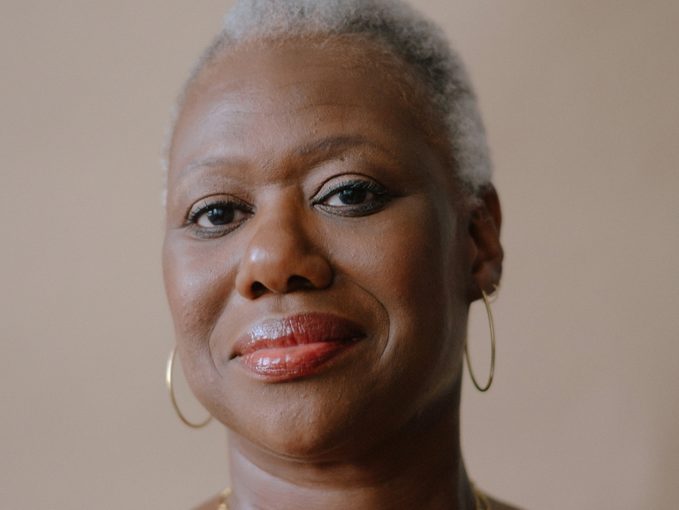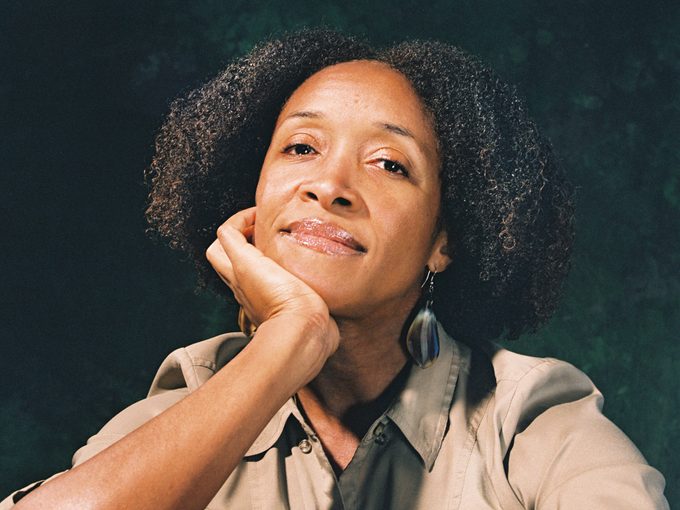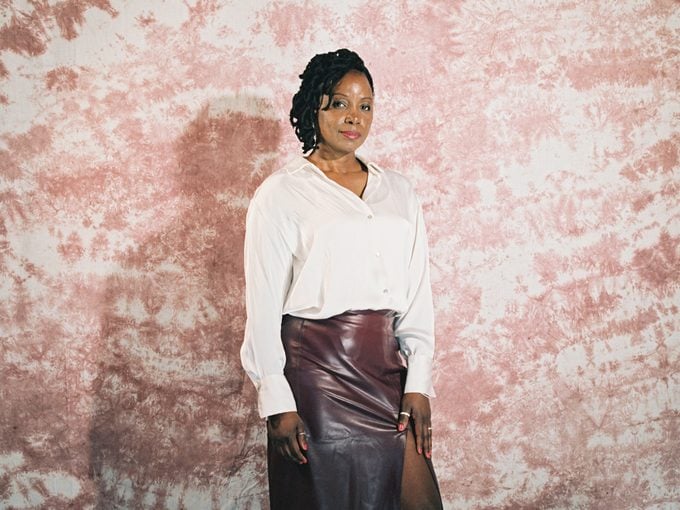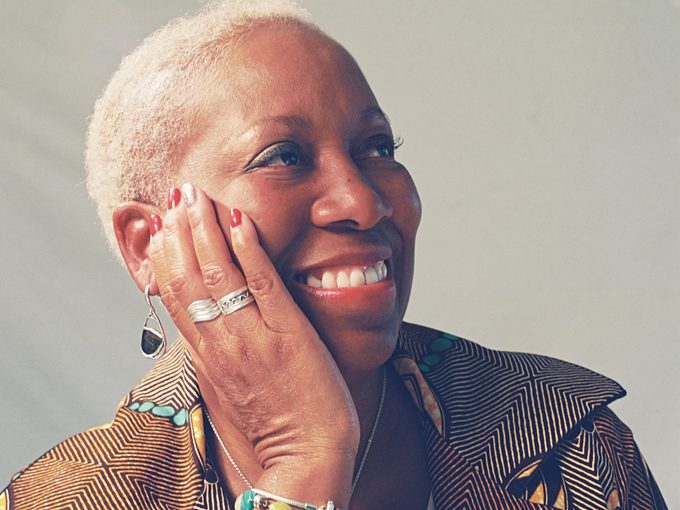Waiting Until Age 50 for Mammograms Is Too Late—Especially for Black Women
Canada’s national breast cancer screening guidelines advise waiting until age 50 for regular mammograms. But many experts, researchers and patients say this approach is too little, too late—especially for Black women.

UPDATE, Nov. 8, 2023: Since this story was first published, the province of Ontario has revised its breast cancer screening guidelines to include mammograms for women who are age 40 or older (instead of age 50 or older). Starting in the fall of 2024, Ontario women over age 40 will be able to self-refer for a mammogram every two years, even if they are not considered high-risk for breast cancer.
Every morning, after completing her skincare regimen, Heather Campbell would rub her fingers in small circles around her breasts, feeling for any changes. On the morning of Friday, October 13, 2017, when she was 44, her fingers bumped against a hard bulge on the side of her left breast. Shocked, Campbell stopped, palpated the lump again and decided she’d wait a day before she worried. Breasts change all the time, she told herself. Then she headed to her downtown Calgary office, where she worked as a chemical engineer. The next morning, she checked her breast once more. The lump was still there.
On Monday, she called her doctor and got an urgent referral for a diagnostic mammogram. Campbell had never had a screening mammogram, which is the best way to detect breast cancer early and is known to reduce deaths from the disease. Canada’s national guidelines, last updated in 2018, recommend that women without a family history of breast cancer have mammograms every two to three years, starting at age 50. Campbell was not due to begin screening for another six years.
She remembers standing there, nervous and topless, with her breast squeezed between two plates. The mammogram was immediately followed by an ultrasound. Afterward, as Campbell sat in the screening room without a shirt or bra on, a radiologist came in and told her: We have concerns.
“I was like, what are you talking about? This is insane,” says Campbell. Cancer didn’t run in her family. She was four months into a dream job at AESO, Alberta’s electric system operator, working on their renewable electricity program. She was dating a man she liked, and she still hoped to have children. Campbell returned to her office, sat down in her cubicle and shook, whispering her worst fears into the phone as she spoke to a friend.
After that, everything moved quickly: a biopsy; a diagnosis of invasive ductal carcinoma, the most common type of breast cancer; then referrals to a surgeon, a medical oncologist, a chemotherapy support class and a fertility clinic.
Over the next six months, Campbell received a half-dozen rounds of chemotherapy, followed by a partial mastectomy that removed 45 percent of her left breast. Staff at the fertility clinic told her that, because of her age, her eggs could not be frozen. Because her breast cancer was estrogen positive—meaning the presence of the hormone in her body contributed to its spread—the medication used to stimulate her ovaries to harvest her eggs would have also stimulated her cancer, making it worse.
(Related: How to Do a Self Breast Exam)
In June 2018, she began a three-week regimen of daily radiation treatments, with Saturdays and Sundays off. To reduce her estrogen levels, she had a full hysterectomy and oophorectomy in July 2020.
Campbell believes that if she had been screened earlier, she would have been diagnosed at an earlier stage, and spared some of the painful treatments that left her scarred, infertile and too sick to continue at her job.
“If I had been screened at 40, I probably would have had a little lumpectomy. Maybe a radiation or two,” says Campbell. “I might have still had children.”
Campbell is one of many patients, researchers and physicians in Canada who are calling for earlier breast cancer screening for all women, but especially for Black women. Delays in screening may be particularly devastating among Black women, but no one can yet say so with certainty here in Canada. Unlike in the United States, Canada does not collect the race-based data that could demonstrate any heightened breast cancer risks for Black women.
But ample evidence from the U.S. shows that Black women are more likely than white women to be diagnosed with aggressive breast cancer at a young age, more likely to be diagnosed with cancer at an advanced stage and more likely to die at a young age from these cancers. Despite these patterns, Black women don’t have the same opportunities for screening, genetic testing, treatment and clinical trial participation as white women, U.S. studies show.
Without race-based data in Canada, there is no evidence to suggest Black women here experience similarly terrible outcomes. And, yet, there is also no evidence to show that they do not.

Aisha Lofters, a family physician and chair in implementation science at the Peter Gilgan Centre for Women’s Cancers at Toronto’s Women’s College Hospital, said she and her colleagues noticed that they were seeing many Black women with aggressive or advanced cancers in their 30s and 40s. These women found lumps on their own—accidentally or during self-exams—rather than by mammograms.
To Lofters, this pattern suggests something is wrong. “Sometimes the best evidence is people’s stories. It’s what they are telling you,” she says.
Lofters is cautious about applying American data to Canadian women. The two countries’ health and economic systems differ enormously, she points out. The populations are not comparable. The Black population in Canada is more diverse genetically than the Black population in the United States. Black women in Canada are more likely to have ancestral roots from throughout Africa, whereas Black women in the U.S. more often have ancestry that can be traced to West Africa, reflecting the deep history of people being taken from nations in that region and enslaved in the Americas.
Moreover, race is not biological, but is a social construct, says Lofters. This is an important distinction: Genetic predispositions to illnesses depend largely on ancestry—where someone’s roots are—and not race. Even so, she says, American research is sending a signal about breast cancer and Black women with West African ancestry that Canadians should not, and cannot, ignore. “We need to recognize that signal, get people aware of it and produce the best research,” she says.
(Related: The Forces That Shape Health Care for Black Women)
In the U.S., non-Hispanic Black women have a 45 percent higher risk for invasive cancers before age 50 than non-Hispanic white women. This study, which was published in the journal Cancer in 2021, found that Black women are more likely to die from breast cancer before they are 50. Another study that looked at nearly 200,000 women between the ages of 40 and 84 who had undergone a screening mammogram found that Black women have a nearly threefold risk for triple-negative breast cancer, one of the most aggressive subtypes.
As a result of this growing body of evidence, the American College of Radiology and Society of Breast Imaging updated their screening recommendations to highlight the heightened cancer risk for Black women and other women of colour. The organizations called for annual mammography screening beginning at age 40 for all women but noted that any delays in screening disproportionately harm women of colour.
In Canada, the national guidelines on cancer screening come from the Canadian Task Force on Preventive Health Care, a committee set up by the Public Health Agency of Canada. The task force consists of 15 volunteers with expertise in primary care and disease prevention. In the most recent guidelines, from 2018, screening mammography for women in their 40s is not recommended. They made the case that the benefits did not outweigh the risks of overdiagnosis—picking up tumours that are unlikely to cause harm. Women aged 50 to 74 should be screened every two years, they said. The authors added a caveat for women in their 40s: Some may wish to be screened based on their values and preferences. “In this circumstance, care providers should engage in shared decision-making with women who express an interest in being screened,” they wrote. But in the studies used by the task force, few Black women were included (they relied heavily on data from Scandinavian countries). And the reality is that Black Canadian women have been diagnosed under the age of 50 after being told they are ineligible for screening mammography.
(Related: Women’s Health Collective Canada Is Addressing the Gap in Women’s Health)

Dawn Barker-Pierre was born in Barbados and moved to Toronto as a child. A mother of three, she wanted a mammogram when she turned 40. When she asked her family doctor, she was told she didn’t need it until age 50. Two years later, she asked again, but was told no a second time: She had no history of breast cancer in her direct family and she was healthy, with no lifestyle behaviours that would increase her risk.
Barker-Pierre had felt dismissed by her doctors before, however, with prior questions about health changes she’d noticed. The first was skin-colour changes under her eyes, which can be associated with thyroid issues, but when she asked for further tests, she was sent to a dermatologist. Eventually, she insisted on getting bloodwork, and persisted until her labs revealed she was suffering from hypothyroidism.
A few months later, at age 44, she discovered a lump in her breast one night while she was watching TV. Her doctor sent her for a mammogram. As the technician performed the scan, she told Barker-Pierre that the healthcare team would not be able to determine when things started changing in her breast because there were no previous scans in her records to compare against. “That floored me,” she recalls.
Barker-Pierre, whose youngest child was 12 at the time, was diagnosed with triple-negative breast cancer, which is typically fast-growing and hard to treat. The cells in triple-negative breast cancer don’t have receptors for the hormones estrogen and progesterone, and they do not, generally, make large amounts of the HER2 protein. But most targeted therapies and medications (like tamoxifen or Herceptin) used in breast cancer treatment go after that protein or those hormone receptors. With triple-negative breast cancers, the main treatment options are chemotherapy, with its host of toxic consequences; surgery; and immunotherapy. Overall, “there are no targeted treatment options for what is a more aggressive cancer,” says Andrea Covelli, a surgical oncologist with Mount Sinai Health Network whose research is focused on health inequities.

Triple-negative breast cancer is more common in Black women, and this has been shown consistently in studies across different countries, says Juliet Daniel, a professor and cancer biologist at McMaster University. Daniel’s work is personal: Her mother died from ovarian cancer four days before Daniel’s undergraduate convocation from Queen’s University, and this came a few months after the death of a close family friend who had breast cancer. These losses shook Daniel, who had planned to pursue medical school. After finishing her bachelor’s degree, she decided she didn’t want to work in a hospital where she might be faced with patients dying of cancer because drugs had not yet been created to treat their disease. Instead, she became a cancer researcher, focused on solutions and treatments. Decades later, in 2009, she herself would face a breast cancer diagnosis.
In 1999, Daniel had discovered a gene that, later, she found was associated with a number of cancers, including triple-negative breast cancer. She named the gene Kaiso, after the West African music that inspired calypso, the musical genre that’s deeply ingrained in the culture of Barbados, Daniel’s birthplace. Over the last 20 years, Daniel has led groundbreaking research showing that Kaiso is highly expressed in the breast cancer tissues of Black women compared to Caucasian women, and that women with high levels of Kaiso expression are less likely to survive breast cancer.
Daniel believes there is more than enough evidence to begin screening women by age 40. “I would say that young Black women should be having a baseline mammogram at the age of 40 if possible,” she says, adding that she would like to see Canada’s national guideline changed to recommend a mammogram for all women at 40, as the risks of screening younger women (such as false positives that could result in needless biopsies or even surgery) are outweighed by the benefits. “The earlier breast cancer is diagnosed, the higher your probability of survival,” she says.
Changing the nationwide recommendations will only address one barrier affecting Black women in Canada when it comes to the prevention and treatment of breast cancer. There is evidence at the provincial level to show that Black women are dealing with multiple obstacles in the cancer care system. This can have deadly or life-altering consequences. In Ontario, research conducted by Lofters and her team has found that women who immigrated from the Caribbean and Latin America wait longer for a diagnosis, are diagnosed at later stages and have a longer interval from diagnosis to the start of chemotherapy for reasons that not well-understood. Another study showed that women in Canada who were born in a Muslim-majority country were less likely to have regular breast cancer screening. In Nova Scotia, Black women are less likely to get mammograms; Black women in that province also told researchers that they had difficulty navigating the health-care system, and that they faced racism from clinicians.
For Daniel, these findings come as no surprise. She often hears stories from women who feel doctors dismissed their concerns about cancer and told them they were too young for a mammogram. “That’s irresponsible,” says Daniel. “At a minimum, they should ask about family history and send those patients for an ultrasound rather than telling the patient they’re too young to have breast cancer.” In many ethnic communities, she notes, women can face a stigma after a cancer diagnosis. When women come in to ask about screening, they should be welcomed into the system rather than turned away, she says.
Daniel and Lofters both work with Olive Branch of Hope, a Toronto-based organization that raises awareness and supports Black women with breast cancer. They want more education among all women about the risks of breast cancer at all ages. They also want better training for physicians, including a designated course on equity, diversity and inclusion where doctors would be educated about cultural sensitivity, including “the challenges that non-white patients experience, and the damage and the hurt that causes to many non-white, equity-seeking, equity-deserving patients, regardless of disease,” says Daniel.
The Canadian task force says it will release an updated, nation-wide breast cancer screening guideline sometime early in 2023. In the meantime, several provinces have modified their policies and brought down the recommended age to begin screening—but whether this increases access for any one individual will depend on where she lives. In British Columbia, Nova Scotia and Prince Edward Island, women in their 40s are encouraged to talk to their doctor, and are eligible for screening every two years. Alberta recently announced a new policy recommending regular mammograms beginning at age 45. All other provinces recommend that screening begin at 50 for women who do not have a family history of breast cancer.
Women of colour are also underrepresented in the research that helps set cancer treatment guidelines—a pattern that reflects, in part, a deep suspicion in the Black community that grew out of historic mistreatment by scientists, says Lofters. She urges women and men who are diagnosed with breast cancer to participate in clinical trials. If research is carried out on mostly white or racially homogeneous populations, “we’re not getting the diversity that we need among people in the trial, and then we don’t know truly how broadly applicable the findings are,” she says. Lofters, Daniel and Covelli are trying to address this in Canada by proactively seeking out Black women to participate in studies to learn about inequities in the system.
(Related: Incredible Black Women Who Are Changing Canadian Health Care)
In Calgary, Campbell is now almost five years out from her diagnosis. Her life looks very different today. She worked throughout her chemotherapy treatments, but found that the drugs left her unable to do basic math in her head, and she felt she could not perform at work in the way she wanted to. “Having to walk away from [my dream job] was almost as heartbreaking as the cancer,” she says. She took time off and returned to the workforce in a different role.
Campbell knows firsthand that disparities exist for Black women with breast cancer, and it goes beyond screenings, diagnoses and prognoses—it’s also a widespread failure to recognize that not all breast cancer patients have the same needs. When Campbell developed skin rashes and facial scars from her chemotherapy, she saw three dermatologists for help with her eczema. They said her concerns were not uncommon in Black patients, but they did not have an answer, she says. A fourth specialist reached out to a group of Black dermatologists who finally offered advice.
Nearly two years after her lumpectomy, Campbell went to a plastic surgeon to discuss breast reconstruction. As she looked through the catalogue with photos of breasts post-surgery, she did not see a single breast of a woman of colour. She couldn’t tell what the scars would look like her on skin. Campbell walked out. She eventually had two reconstruction surgeries, using a newer technique: autologous fat grafting, in which fat is removed from her abdomen and injected into the breast.
Campbell still feels frustrated that Canada does not collect the race-based data that could identify any disparities experienced by Black women with breast cancer. These gaps exist here, independent of socioeconomic status, she insists. In the absence of data, stories like hers are the best evidence we have.
“I’m not poor. I’m an engineer. My second degree is in law. I can read all the medical information quite fine. I even know how the drugs I use are made,” says Campbell. “So help me understand why I had such a miserable time with breast cancer. It has nothing to do with my poverty or access to medical care.”
Next: As a Cancer Journey Coach and Breast Cancer Survivor, I’m Changing the Narrative for Cancer




